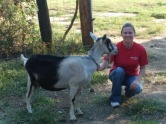Myra's Memoir
Myra Henry November 11,2008 Volume 1, Issue1
A Little Something About Myself

My name is Mrs. Myra Henry and I recently graduated from Union University with a bachelor of science in elementary education, K-6. I am a resident of Henderson County and enjoy living in Tennessee with my husband, Greg, and two children, Adrian and Heath. Together we live a busy but fulfilling life. Two things in my life that keep me fulfilled are my children and hobbies.
Adrian and Heath both attend school at Bargerton Elementary in Henderson County. Adrian plays girls’ varsity basketball for the Bargerton Rebels and also enjoys showing her team spirit by being a cheerleader. Heath plays basketball for the boys’ Jr. Varsity Rebels. With both of them actively involved in sports, we are on the go quite a bit attending games. I find it both exciting and a lot of fun!
Another way I stay fulfilled is through my hobbies. I love science and being outside. Therefore, flowers and plants are right up my alley; even though I am far from having a green thumb! I also enjoy the animals that live on our land. Beside the wild deer and turkeys; we have three cats, two milk goats, a guinea pig and a hermit crab. We hope to add chickens soon! It takes a lot of love and care to keep all the critters happy and healthy, but lucky for them I am quite the nurturer!
Nurturing is a quality I carry with me to the classroom. As your child’s teacher I will be nurturing and caring, yet consistent and fair. These are qualities I feel are important to maintain a well managed classroom. I want to thank you for the opportunity to be your child’s teacher. I look forward to working with you as we guide your child to new discoveries and a love for learning!
On the Farm
The field trip our class took to the farm was a great success! We began our experience by being introduced to all the animals. First, we saw a lot of milk goats of varying ages and a pig named Wilbur. Then we moved to the birds and saw ducks, turkeys, guineas, and bantams. We discovered there were a lot of animals to care for, but also many benefits to reap!
To begin with, we helped the farmer take care of the animals. He has to be sure all the animals have fresh water each day. Then all the animals have to be fed. The goats eat grass during the warm months, but have to be fed hay during the winter. Their diet is also supplemented with soy pellets and sweet feed. The farmer even has to provide the goats with a mineral block to ensure they get all the vitamins they need. The children were happy to know they weren’t the only ones taking Flintstone vitamins! The pig on the other hand, will eat about anything! But he is mostly fed corn. Corn is also a staple food for the ducks, turkeys, guineas, and bantams; although they are also fed laying mash. Finally, all the animals are provided a shelter to escape from harsh weather and predators. The goats go to the barn, the pig goes to his shed, and the birds go to their coops. They are also protected by the electric fence. It’s a lot of work, but all the animals appreciate it!
After all the work, the farmer can reap his benefits! We watched as he milked the goat, which was a class favorite! Unfortunately for the pig, the farmer will eventually get meat from him. Also, we helped the farmer gather eggs from the various birds. The eggs that are not eaten are hatched into babies and sold. From our shoes, we discovered all the animals also produce lots of poopy, which makes great fertilizer! This results in the farmer growing a healthy garden and orchard. The farmer eats vegetables from the garden, feeds corn from the garden back to the animals, and uses gourds from the garden to make purple martin houses. In return, the purple martins eat pesky mosquitoes.
After reflecting on the long day at the farm, we discovered several things. First, the animals need food, water, and shelter to survive and stay healthy. Second, the animals need plants to eat and the plants need the animals to provide fertilizer. Third, the animals and farmer depend on each other to provide their needs. Through these mutual relationships a successful farm environment is produced. As you can tell, we enjoyed our field trip and learned a lot, too! If you would like to join us on the field trip, minus the messy shoes, CLICK HERE!
